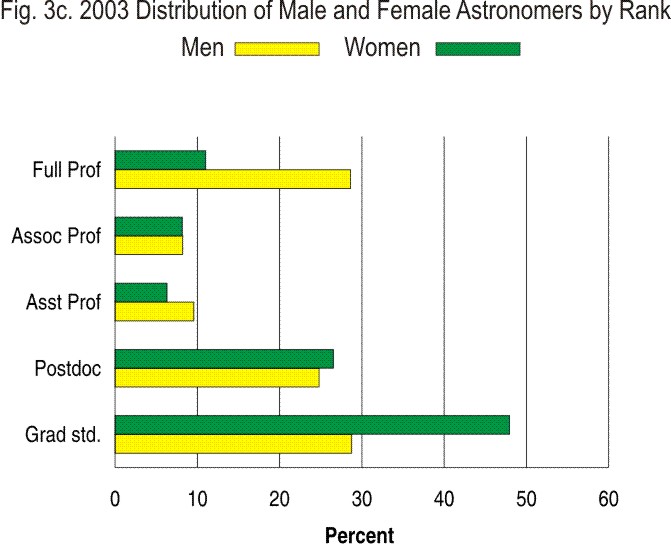| NOTE: For
the most
recent
results and more detailed
analysis, please see my Survey
Results Page or my June 2004 STATUS article "Portrait of a Decade". --JLH |
| |
Results from the 2003 CSWA Survey
|
|
|
|
Karen B. Kwitter, Williams College and the AAS Committee on the Status of Women in Astronomy Download the entire 14-page poster: Postscript (426K) CorelDraw (111K) |
|
List of surveyed institutions Downloadable survey data |
| Figures 1 and 2 show the absolute numbers and the
fractions of
astronomers who are men and women, for all three years of the survey.
Rank increases to the right in these graphs; "faculty" and "research"
professors are combined at each rank. |
||
 Figure 1 |
 Figure 2 |
|
| The percentage of women continues to increase
with time at nearly all levels,
with the largest increase at the graduate student level; 30% of
graduate
students in astronomy are now women. The historical decrease in the
percentage of women with increasing rank persists. We also find that
both
the number and the percentage of female assistant professors have
decreased
since 1999, which may be cause for concern (however, the 2002 AIP survey
results do not show this decline). The job market may be worsening again; we see an increase in the number of postdocs but decreases in the numbers of assistant and associate professors since 1999. |
||
| The CSWA
surveys asked
institutions to distinguish between "research" and "faculty" professors
in their responses. Figure 4 shows the percentages of faculty
astronomers
who are men and women; Figure 5 shows the same for research astronomers. |
|
 Figure 4 |
 Figure 5 |
| Overall, women are better represented among
faculty than among researchers.
This suggests that women are not more likely than men to hold
soft-money positions. In fact, we find that among assistant professors
in 2003,
women are more likely than men to be classified as "faculty" (60% of
female
assistant professors are faculty, compared with 40% of male assistant
professors; the distributions are similar at all other ranks). |
|
| Other interesting results from this survey: |
||
| => | The percentage of women among current postdocs is
approximately
the same (22%) as the percentage of women among graduate students in
1992 and
among Ph.D. recipients in astronomy in 2000 and 2001 (PhD statistics
from
the NSF 2001 Science
and Engineering Doctorate Awards report). But the percentage of
women
in graduate school appears to be increasing faster than the percentage
of
women at the postdoctoral level. |
|
| => | There were a third as many female assistant professors in
2003 as
female postdocs in 1999; for men, the fraction was one half. |
|
| => | Female graduate students are better represented at public
universities
than at private schools, but the opposite is true for female full
professors. |
|
| This survey had several limitations. We encountered
difficulties
in standardizing the professorial ranks and faculty/research
distinction from
institution to institution. Though we attempted to keep the sample as
similar
as possible to the 1992 and 1999 samples, this occasionally proved
difficult
as well; it was not alway clear which criteria had been applied in the
past,
or even which people at a given institution should be considered
astronomers!
Statistical complications included small numbers and the possibility of
counting people with multiple affiliations more than once. However, we
feel
this survey provides a robust view of the overall progression of women
and
men into our profession. Like any good scientific study, this survey raised many new questions. For example, what factors contribute to the persistent decrease in the percentage of women with rank? Is there significant attrition of women during graduate school? Future studies can complement this one by focusing on more narrowly-defined groups and seeking more detailed information. |


